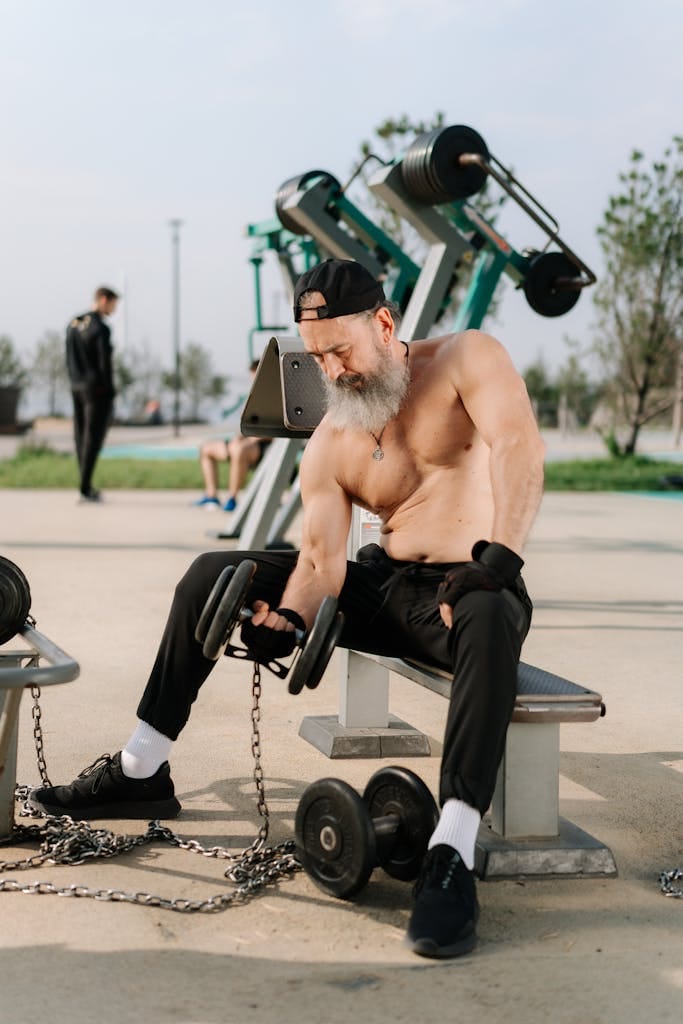FREE SHIPPING OVER $50
Want a Younger Brain? Science Says This Workout Combo Beats Crosswords
Imagine having a brain that stays sharp, agile, and youthful as you age. While many people believe that doing brain games like crosswords is the key to maintaining mental acuity, emerging science suggests that a well-rounded workout combining strength training and cardio could be even more effective. In this article, we’ll explore how this powerful workout combo can help you achieve a younger brain, backed by scientific insights and practical tips.
Exercise does more than just build muscles or burn calories—it rejuvenates your brain. Strength training and cardio work together to improve blood flow, reduce inflammation, and stimulate the growth of new brain cells. Researchers now believe that these benefits might give you an edge over traditional brain games when it comes to boosting cognitive function and delaying the onset of age-related mental decline.
The Link Between Physical Activity and Brain Health

Modern research reveals a strong connection between physical fitness and cognitive vitality. As you age, your brain naturally undergoes changes that can affect memory, focus, and overall mental performance. However, regular physical activity can help counteract these effects by improving neuroplasticity—the brain’s ability to reorganize and form new neural connections.
Strength training increases the production of growth factors, proteins that support the survival of existing neurons and the creation of new ones. Cardio, on the other hand, enhances cardiovascular health, ensuring that your brain receives ample oxygen and nutrients. Together, these exercises create a potent environment for brain rejuvenation.
In fact, studies have shown that older adults who engage in both strength and cardio exercises demonstrate better cognitive performance than those who rely solely on brain games like crosswords. Physical exercise’s holistic benefits, including reduced stress, improved mood, and enhanced sleep quality, all contribute to a younger, healthier brain.
The Science Behind the Workout Combo
Recent scientific studies have increasingly focused on how combining strength training and cardio can influence brain health. Let’s explore the key mechanisms at work:
- Improved Blood Flow:
Both forms of exercise boost heart health and circulation. With improved blood flow, your brain gets more oxygen and essential nutrients, which can enhance cognitive functions and support neural repair. - Reduction in Inflammation:
Chronic inflammation is a major factor in brain aging. Exercise lowers the levels of inflammatory markers in the body, which can help protect brain cells from damage and promote a more youthful neural environment. - Neurogenesis and Synaptic Plasticity:
Regular physical activity stimulates the production of brain-derived neurotrophic factor (BDNF), a protein that encourages the growth of new neurons and strengthens connections between them. This is crucial for maintaining learning, memory, and overall cognitive flexibility. - Hormonal Balance:
Exercise helps regulate stress hormones like cortisol. High levels of cortisol can be harmful to the brain over time, so keeping these hormones in check is key to preventing cognitive decline.
7 Brain-Boosting Benefits of the Workout Combo
Below is a numbered list outlining the top benefits of integrating strength training and cardio into your exercise routine. Each element is presented in the “Title: Description” format.
- Enhanced Cognitive Function: Increased blood flow and growth factors improve memory and mental clarity.
- Neuroprotective Effects: Reduced inflammation and controlled stress hormones protect against brain cell damage.
- Improved Neuroplasticity: Exercise stimulates BDNF production, fostering new neural connections for lifelong learning.
- Better Mood and Reduced Stress: Regular workouts decrease anxiety and depression, contributing to a healthier brain environment.
- Increased Energy Levels: A balanced exercise regimen helps maintain high energy, which supports both physical and mental performance.
- Faster Recovery and Resilience: The combination of strength and cardio enhances recovery, making the brain more resilient to daily stress.
- Long-Term Brain Health: Consistent exercise contributes to delaying the onset of cognitive decline and age-related diseases.
Each benefit supports the idea that a well-structured workout routine can be a game-changer in maintaining and even improving brain function as you age.
How to Incorporate This Workout Combo into Your Routine
The exciting part about this approach is that it doesn’t require a gym membership or complicated equipment. Here are some practical steps to integrate a combination of strength training and cardio into your daily life:
- Start with a Warm-Up:
Begin with a 5-10 minute warm-up to get your body ready. Light cardio, like brisk walking or jumping jacks, prepares your muscles and increases blood flow to the brain. - Alternate Strength and Cardio:
Design your workout sessions to include both elements. For example, perform a set of body-weight exercises like squats, push-ups, or lunges, then transition to a short burst of cardio such as running or cycling. This alternation helps maximize both muscle-building and cardiovascular benefits. - Create a Structured Routine:
Aim for at least three to four workout sessions per week. Each session could last 30-45 minutes, with a mix of 15-20 minutes dedicated to strength training and 15-20 minutes to cardio. Consistency is crucial, so schedule workouts at times that work best for you. - Incorporate Interval Training:
High-Intensity Interval Training (HIIT) is an excellent method that blends strength and cardio. HIIT involves short bursts of intense exercise followed by brief periods of rest. This type of workout not only improves fitness quickly but also stimulates the production of growth factors beneficial for the brain. - Listen to Your Body:
Always pay attention to how your body responds to exercise. Gradually increase intensity to avoid injuries, and ensure you allow adequate recovery time between sessions. Balance is key—overtraining can lead to stress and counteract the benefits. - Mix It Up:
Variety helps maintain motivation. Try different forms of cardio, such as swimming, cycling, or even dancing, and rotate strength exercises to target various muscle groups. A diverse workout routine keeps your body challenged and your mind engaged. - Combine with Other Healthy Habits:
Don’t rely solely on exercise. Integrate other longevity practices such as a balanced diet rich in Omega-3s, regular sleep, and mindfulness practices. These complementary habits work together to enhance brain health and overall well-being.
Real-Life Success Stories and Research Insights
Many individuals have already experienced remarkable improvements in their cognitive abilities by embracing this balanced workout regimen. For example, a study found that older adults who participated in a combined strength and cardio program showed significant enhancements in memory, attention, and processing speed compared to those who engaged only in sedentary activities or solely focused on brain games.
Additionally, numerous fitness enthusiasts report feeling more alert, less stressed, and mentally sharper after incorporating these exercises into their routines. They describe a noticeable boost in energy and a reduction in the “foggy” feeling that often comes with aging. Such testimonials are supported by science, making a compelling case for the transformative potential of a well-rounded workout routine.
Additional Tips for Maintaining a Youthful Brain
To further maximize the benefits of your workout combo, consider adopting these additional practices:
- Mindful Movement:
Incorporate mindfulness into your workouts by focusing on your breathing and body sensations. This not only improves the quality of your exercise but also reduces stress. - Social Engagement:
Exercise with a friend or join a fitness group. Social interaction during workouts can boost your mood and add an extra layer of cognitive stimulation. - Continuous Learning:
Keep challenging your brain outside of workouts. Read, learn new skills, or try creative hobbies. This mental stimulation complements the physical benefits of your exercise routine. - Stay Hydrated and Eat Well:
Proper hydration and a balanced diet rich in antioxidants and Omega-3 fatty acids are essential. They provide the necessary fuel for your workouts and support the recovery process. - Regular Health Check-Ups:
Monitoring your health through periodic check-ups ensures that you can adjust your fitness regimen as needed. Keeping an eye on blood pressure, cholesterol levels, and cognitive function can help you optimize your approach to longevity.
Conclusion
While traditional brain games like crosswords have their place, emerging science suggests that a dynamic workout combo of strength training and cardio offers a more potent boost for brain health. This powerful duo not only enhances physical fitness but also stimulates neurogenesis, improves blood flow, and reduces inflammation, all of which are key to maintaining a younger, more agile brain.
Related Articles
- How This 60-Year-Old Defied Aging and Feels 30 Every Day
- I Slashed My Metabolic Age by 18 Years After 50—Here’s Exactly How You Can Too
- Why the Risk of Dying from This Disease Increases After 50—And How to Prevent It
- Top 10 Healthy Snacks That Might Be Silently Wrecking Your Heart After 60
- This Vitamin Could Be the Key to Living Longer—Here’s What Scientists Found



